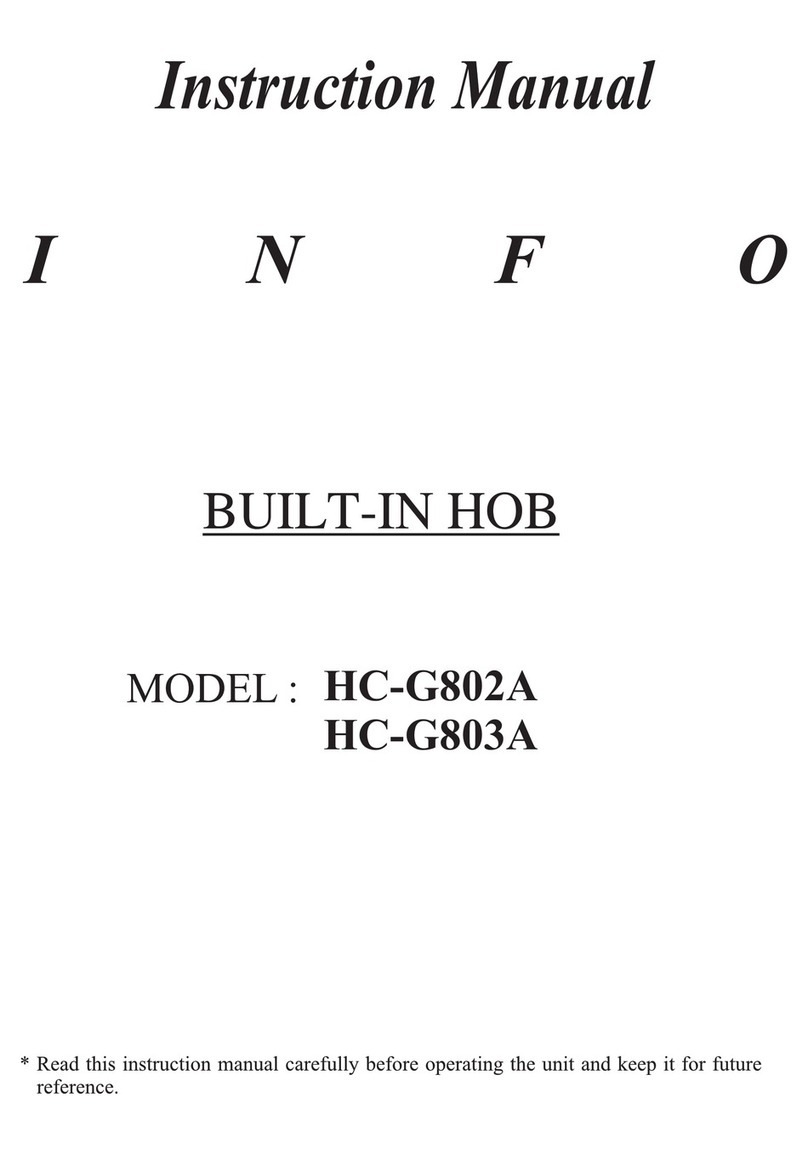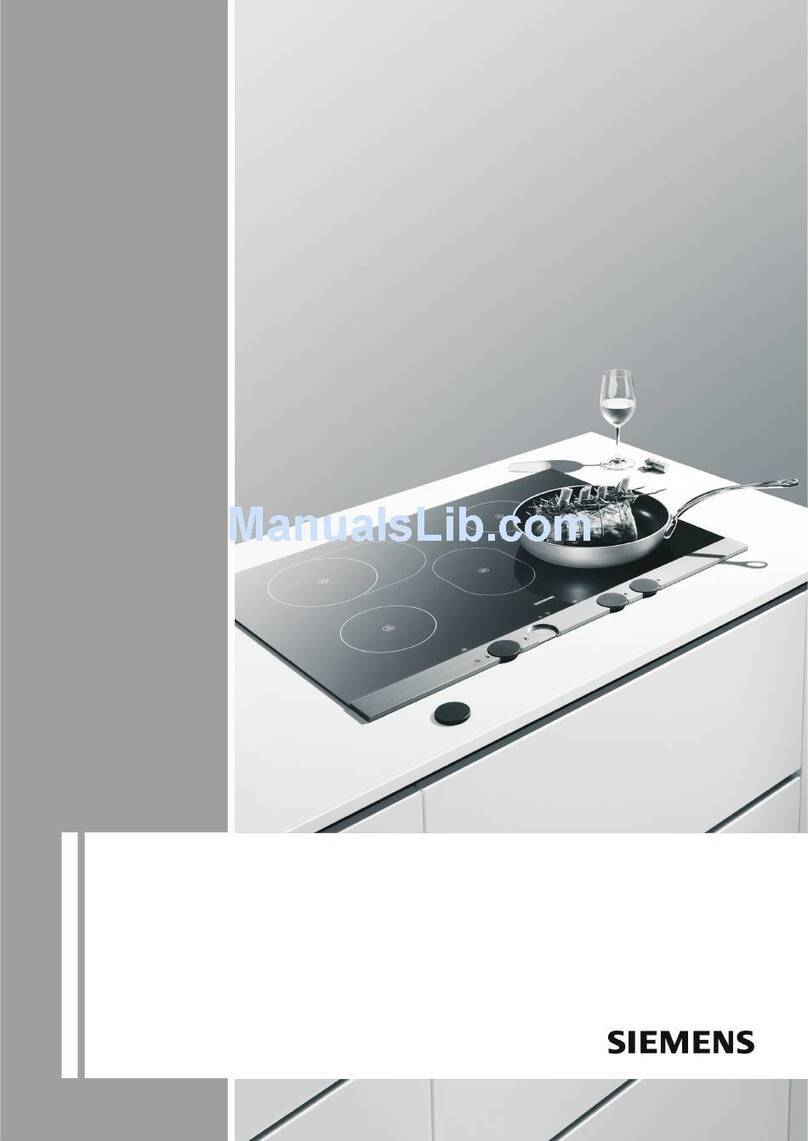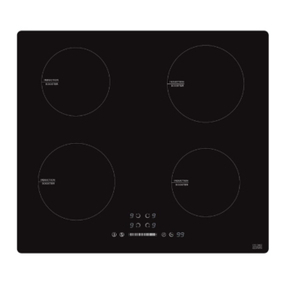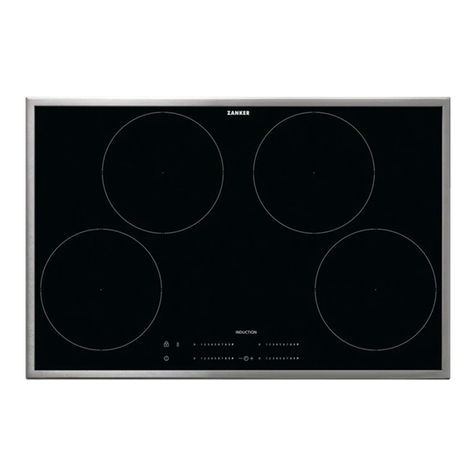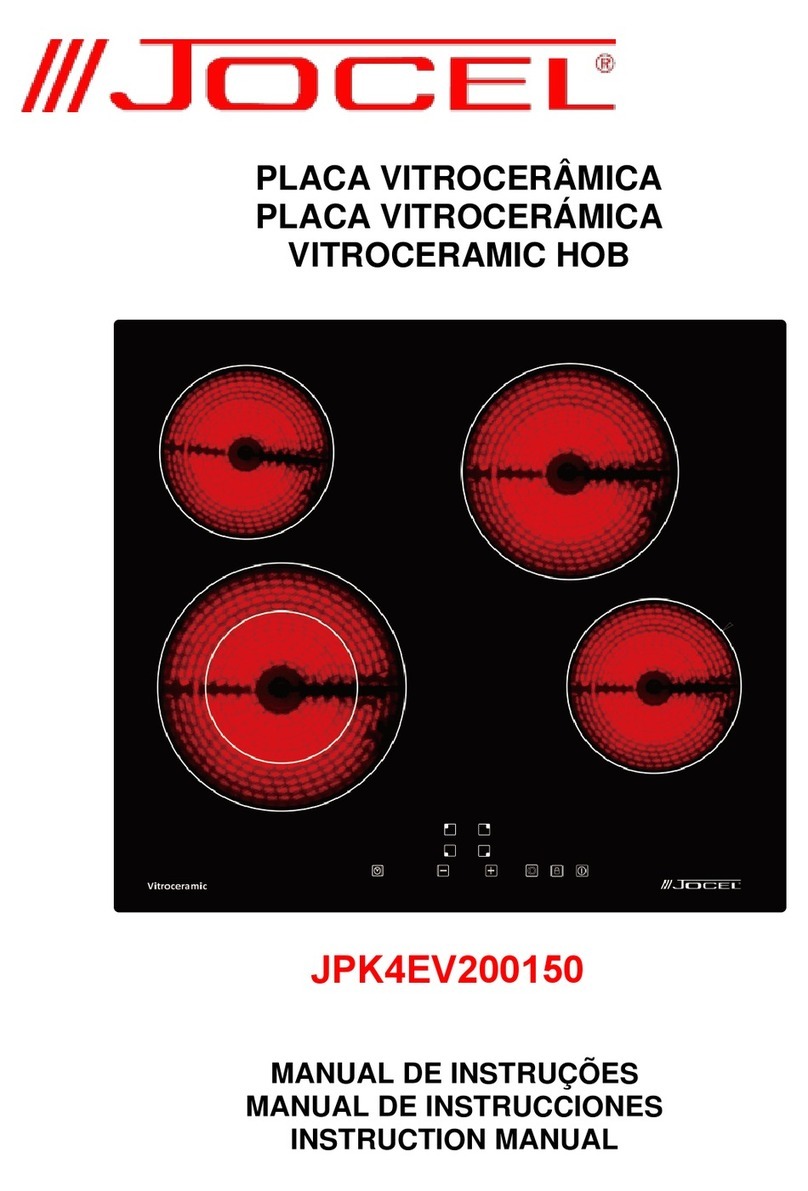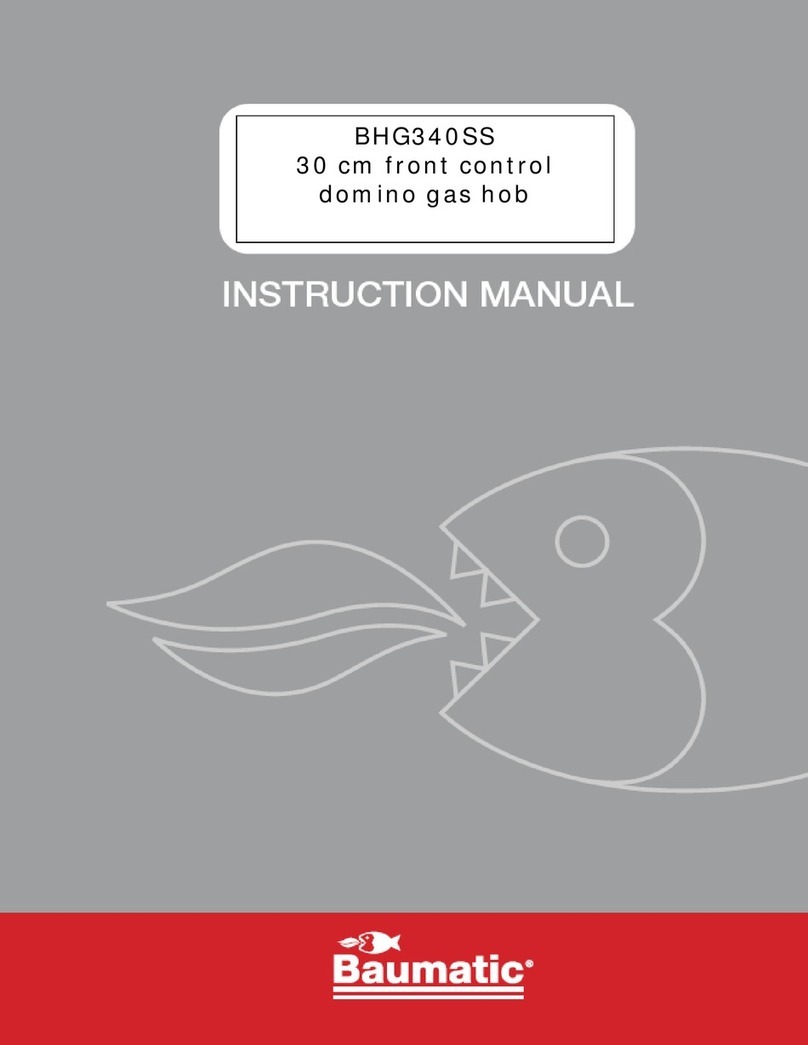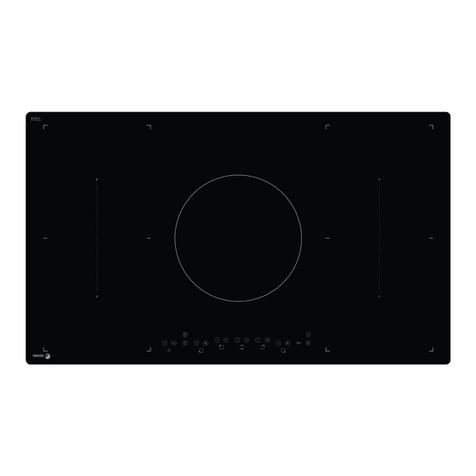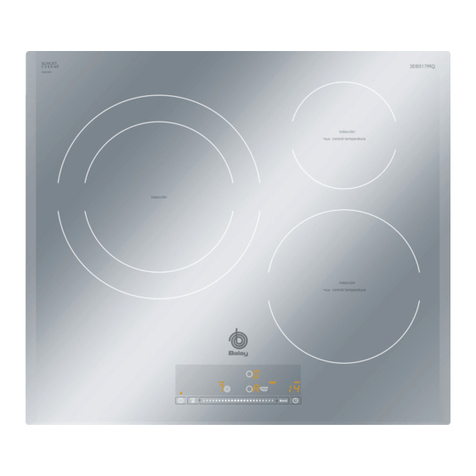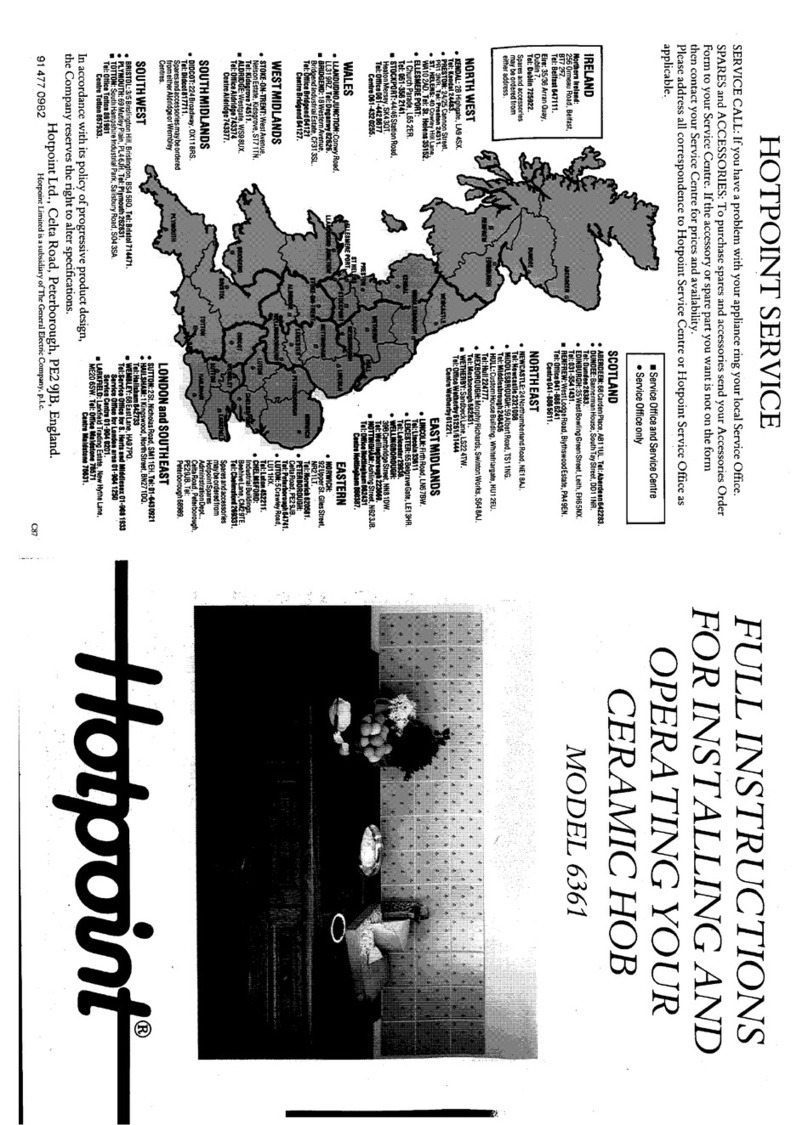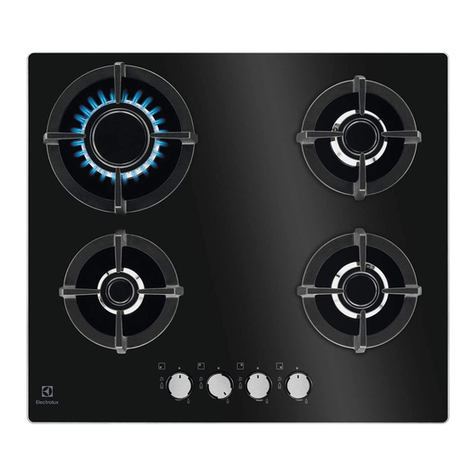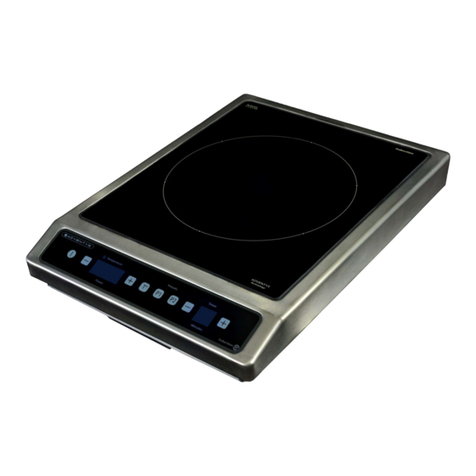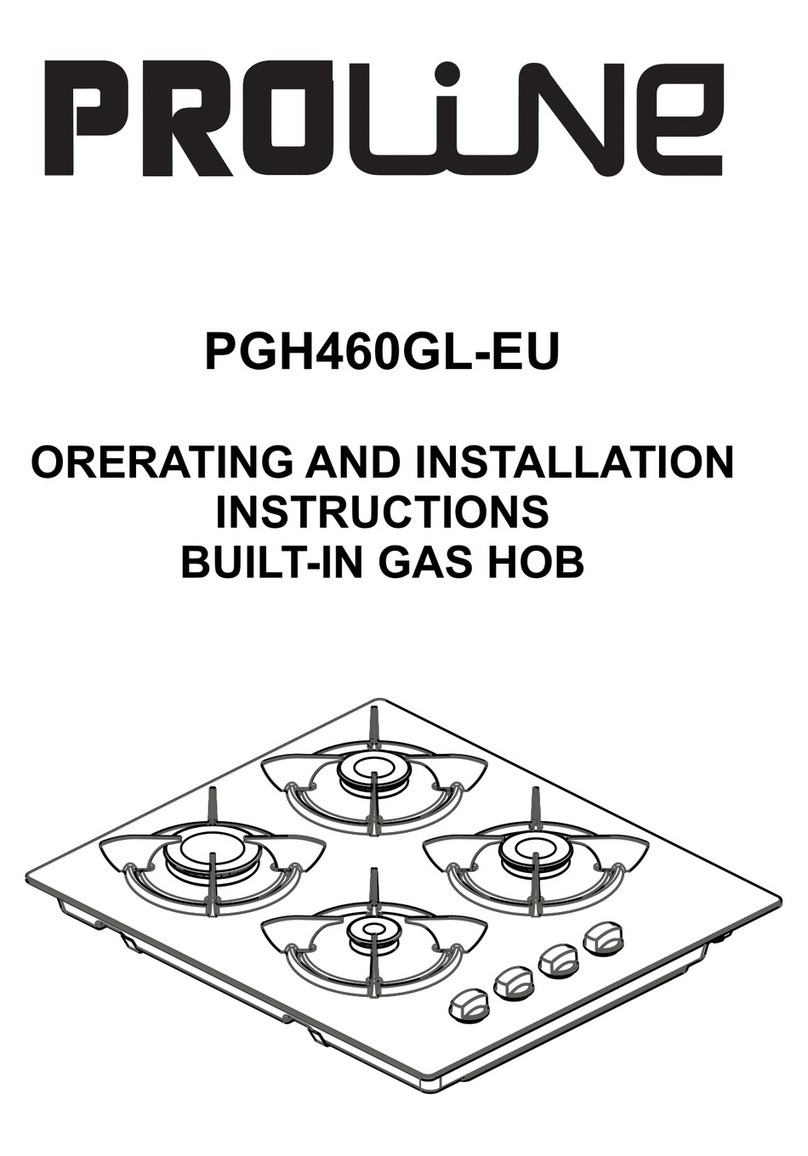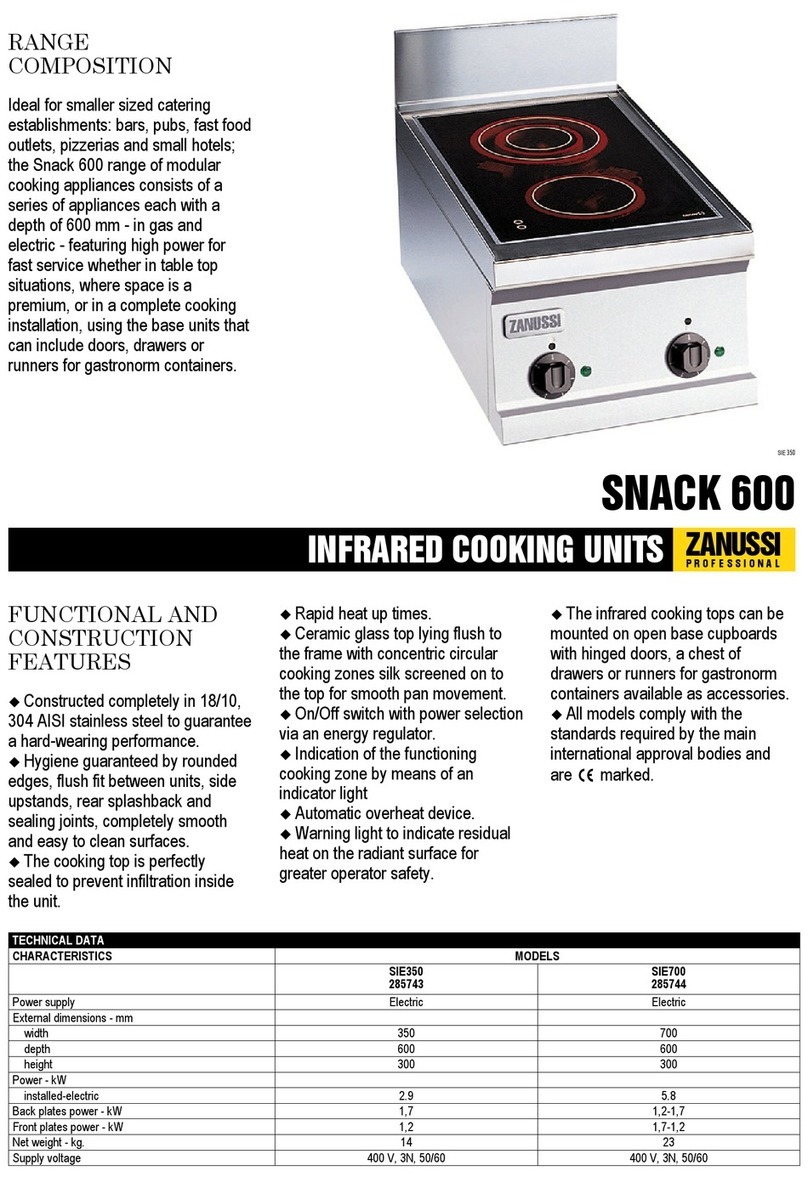Smalvic PVC Installation and operating instructions

CERAMIC
COOKING HOBS
PVC
Instructions for the use - Installation advices
KEEP IN A SAFE PLACE
Before operating this hob,
please read these instructions carefully

2

Dear Customer,
Thank you for having purchased and given your preference to
our product.
The safety precautions and recommendations given below are
for your own safety and that of others. They will also provide a
means by which to make full use of the features offered by your
appliance.
Please keep this booklet carefully. It may be useful in future,
either to yourself or to others if doubts should arise relating to
its operation.
This appliance must be used only for the task it has explicitly
been designed for, that is for cooking foodstuffs.
Any other form of usage is to be considered as inappropriate
and therefore dangerous.
The manufacturer declines all responsibility in the event of
damage caused by improper, incorrect or unreasonable use of
the appliance.
DECLARATION OF
CE
CONFORMITY
– This appliance has been designed to be used only for cooking. Any other use
(such as heating a room) is improper and dangerous.
– This appliance has been designed, constructed, and marketed in compliance with:
- Safety requirements of EU Directive "Low Voltage" 2006/95/EC;
- Protection requirements of EU Directive "EMC" 89/336/EEC;
- Requirements of EU Directive 93/68/EEC.
3

IMPORTANT PRECAUTIONS AND RECOMMENDATIONS
✓
After having unpacked the appliance, check to ensure that it is not damaged.
If you have any doubts, do not use it and consult your supplier or a professionally
qualified technician.
✓
Packing elements (i.e. plastic bags, polystyrene foam, nails, packing straps, etc.)
should not be left around within easy reach of children, as these may cause serious
injuries.
✓
The packaging material is recyclable and is marked with the recycling symbol
.
✓
Do not attempt to modify the technical characteristics of the appliance as this may
become dangerous to use.
✓
Household appliances are not intended to be played with by children.
✓
eep children away from the appliance during use.
✓
Children, or persons with a disability which limits their ability to use the appliance,
should have a responsible person to instruct them in its use. The instructor should be
satisfied that they can use the appliance without danger to them selves or their sur-
roundings.
✓
The appliance was designed for non-professional use by private individuals in com-
munal dwellings.
✓
The manufacturer cannot be considered responsible for damage caused by unreason-
able, incorrect or rash use of the appliance.
✓
If you should decide not to use this appliance any longer (or decide to substitute an
older model), before disposing of it, it is recommended that it be made inoperative in
an appropriate manner in accordance to health and environmental protection regula-
tions, ensuring in particular that all potentially hazardous parts be made harmless,
especially in relation to children who could play with old appliances.
✓
The appliance should be installed and all the electrical connections made by a quali-
fied engineer in compliance with local regulations in force and following the manufac-
turer's instructions.
✓
If you note a crack in the cooktop, switch the appliance off immediately and call the
After-Sales Service.
IMPORTANT INFORMATION FOR CORRECT DISPOSAL OF THE
PRODUCT IN ACCORDANCE WITH EC DIRECTIVE 2002/96/EC.
(for European Union countries only)
At the end of its working life, the product must not be disposed of as
urban waste. It must be taken to a special local authority differentiated
waste collection centre or to a dealer providing this service.
Disposing of a household appliance separately avoids possible negative
consequences for the environment and health deriving from inappropri-
ate disposal and enables the constituent materials to be recovered to
obtain significant savings in energy and resources. As a reminder of the
need to dispose of household appliances separately, the product is
marked with a crossed-out wheeled dustbin.
4

IMPORTANT PRECAUTIONS AND RECOMMENDATIONS FOR
USE OF ELECTRICAL APPLIANCES
Use of any electrical appliance implies the necessity to follow a series of fundamental rules.
In particular:
✓
never touch the appliance with wet hands or feet;
✓
do not operate the appliance barefooted;
✓
do not allow children or disabled people to use the appliance without your supervision.
The manufacturer cannot be held responsible for any damages caused by improper, incorrect
or unreasonable use of the appliance.
TIPS FOR THE USER
✓
During and immediately after use some parts of the hob can reach very high tempera-
tures. Do not touch them.
✓
eep children away when the hob is in use.
✓A
fter use, ensure that the knobs are in the off position.
✓
Before any cleaning or maintenance, switch off the electricity to the cooktop.
Risk of fire!
✓
Do not leave inflammable material on the cooktop.
✓
Make sure that the electrical cables of other appliances installed nearby cannot come
into contact with the cooktop.
✓
Never cook the food directly on the ceramic zones, but in special pans or containers.
✓Do not allow heavy or sharp objects to drop on the glass ceramic hob. If the hob is
cracked or otherwise damaged by falling objects etc., disconnect the electrical power
cord and call Customer Service.
✓Do not scratch the hob with sharp objects. Don't use the hob as a work surface.
5

FEATURES
1
8
7
5
1
234
6
9
10
11
12
0
8
7
5
1
234
6
9
10
11
12
0
8
7
5
1
234
6
9
10
11
12
0
8
7
5
1
234
6
9
10
11
12
0
0
1
2
3
4
5
6
0
1
2
3
4
5
6
0
1
2
3
4
5
6
8
7
5
1
234
6
9
10
11
12
0
0
1
2
3
4
5
6
0
1
2
3
4
5
6
0
1
2
3
4
5
6
0
1
2
3
4
5
6
(Fig. 1.1)
This model features 2
halolight cooking
zones
and 2 radiant zones.
The 4 heating plates are controlled by
“infinite control” switches.
The heat power can be adjusted without
steps from “0” to its max “12”.
(Fig. 1.3)
This model features 4 “3 circuits” radi-
ant zones.
The hotplates are controlled by 7-posi-
tion switches (0 ÷ 6).
The heat power can be increased by
steps from “0” (off) to “6” (max).
(Fig. 1.2)
This model features
1 halolight cooking
zone
and 3 “3 circuits” radiant zones.
The halolight hotplate is controlled by
an “infinit control” switch, while the 3 “3
circuits” radiant zones are controlled by
7-position switches (0 ÷ 6).
The heat power of the halolight hotplate
can be adjusted without steps from “0”
to its max “12”.
The heat power of the “3 circuits” radiant
zones can be increased by steps from
“0” (off) to “6” (max).
Fig. 1.1
Fig. 1.2
Fig. 1.3
6

7
FEATURES
(Fig. 1.4)
This model features 4
HiLight radiant
cooking
zones.
The 4 heating plates are controlled by
“infinite control” switches.
The heat power can be adjusted without
steps from “0” to its max “12”.
(Fig. 1.5)
This model features
1 double
radiant
cooking zone
and 3 “3 circuits” radiant
cooking
zones.
The “3 circuits” radiant
cooking
zones
are controlled by 7-position switches (0
÷ 6). The heat power can be increased
by steps from “0” (off) to “6” (max).
The double radiant hotplate is con-
trolled by “infinite control” switch.
The heat power
can be adjusted
without steps from “0” to its max “12”.
By switching on the second element the
surface area can be extended. For this
purpose, turn the control knob to the
position
.
8
7
5
1
234
6
9
10
11
12
0
8
7
5
1
234
6
9
10
11
12
0
8
7
5
1
234
6
9
10
11
12
0
8
7
5
1
234
6
9
10
11
12
0
0
1
2
3
4
5
6
0
1
2
3
4
5
6
0
1
2
3
4
5
6
8
7
5
1
234
6
9
10
11
12
0
Fig. 1.4
Fig. 1.5

8
All models have the temperature control knobs located on the right hand side of the
hob.
These knobs are wired as follows (Fig. 1.6):
1Rear right plate
2Rear left plate
3Front left plate
4Front right plate
The hob is provided with a signal lamp (5) which lights up when the hob is switched on.
The hob also features 4 warning lamps (6) which are wired to the corresponding plate.
They warn of any remaining heat in a hotplate and switch off when the temperature of
the relevant cooking-plate falls below 60 C°.
1
2
3
4
5
6
Fig. 1.6

9
Never cook food directly on the
ceramic zones! Always use a
saucepan or special container.
8
7
5
1
234
6
9
10
11
12
0
0
1
2
3
4
5
6
Fig. 2.1
Fig. 2.2
HOW TO USE THE HOB
2
Before you switch the hob on make
sure that it is clean.
To switch a cooking plate on you must
turn the relevant control knob as follows:
odel in figure 1.1
- turn clockwise
odel in figure 1.2
- turn clockwise for
halolight
plate
- turn anticlockwise for “3 circuits”
radiant plates
odel in figure 1.3
- turn anticlockwise
odel in figure 1.4
- turn clockwise
odel in figure 1.5
- turn clockwise for
double
radiant
plate
- turn anticlockwise for “3 circuits”
radiant plates
When the hob is on, the signal lamp “5”
of fig. 1.6 is lit-up.
When the temperature of a cooking
plate is over 60°C, the relevant warning
lamp “6” of fig. 1.6 is also lit-up to warn
of heat on the surface of the hob.
This lamp also stay on after the cooking
plate has been switched off to shown
that the hob surface is still hot.
This residual heat lasts for a rather long
time after the cooking plate has been
switched off.
During this spell of time you should
avoid touching the hob surface over
the cooking plate; please pay espe-
cial attention to children.
The lamp will switch off automatically as
soon as the surface temperature of the
cooking plate falls below 60°C.
8
7
5
1
234
6
9
10
11
12
0
Fig. 2.3

10
TYPE OF HOTPLATES
Halolight zone (Fig. 2.4)
Incorporating 1 halogen ring lamp and 1
heating element in the middle of the
halogen ring.
Instantly reaches the working tempera-
ture and is controlled by a continuous
energy regulator
(fig. 2.1)
from 1 (mini-
mum position) to 12 (maximum temper-
ature).
Warning for eyes:
Do not stare at the halogen lamp
when it is on.
Radiant hotplate (Fig. 2.5)
Consisting of concentric rings allowing
an even heat distribution to the radiant
surface.
Controlled by “infinite control” switch
(fig. )
.
“3 circuits” radiant hotplate
(Fig. 2.6)
Incorporating 3 heating elements you can
control and light up all together or sepa-
rately by a 7 position switch (fig. 2.2).
Reaches the working temperature in
very short time.
Fig. 2.4
"Halolight" zones
- Ø 145 mm 1200 W (at 230 V)
- Ø 180 mm 1800 W (at 230 V)
Fig. 2.6
"3 circuit" radiant zones
- Ø 145 mm 1200 W (at 230 V)
- Ø 180 mm 1700 W (at 230 V)
- Ø 195 mm 1900 W (at 230 V)
Fig. 2.5
"Radiant” zones
- Ø 145 mm 1200 W (at 230 V)
- Ø 180 mm 1800 W (at 230 V)
2.1

11
“Hi light” radiant zone (Fig. 2.7)
The heating element is formed of a coil
of resistant material which reaches the
working temperature quickly.
Operation of the cooking zone is con-
trolled by a continuous energy regulator
(fig. 2.1)
from 1 (minimum position) to 12
(maximum temperature).
Double radiant hotplate
(Fig. 2.8)
The heating element is formed of a coil
of resistant material which reaches the
working temperature quickly.
Operation of the cooking zone is con-
trolled by a continuous energy regulator
(fig. 2.3) from “1” to “12” (maximum
temperature).
By switching on the second element,
the surface area of the radiant zone can
be extended.
For this purpose, turn the control knob
(fig.
2.3
)
fully to the right (position
).
Caution! the cooking hob becomes very hot during operation.
Keep children well out of reach.
Do not scratch the cooktop with cutting or sharp objects.
Do not use the cooktop as a work surface.
Fig. 2.7
"Hi-light" radiant zones
- Ø 145 mm 1200 W (at 230 V)
- Ø 180 mm 1800 W (at 230 V)
Fig. 2.8
"Double" radiant zone
- Ø 180/115 mm 1700/650 W (at 230 V)
Second
element

12
COOKING HINTS
✓To reduce the cooking time, you can turn the control knob to the max when you
switch the plate on. After a short time you will set the control knob to the required
position for the cooking.
✓You should use pots and pans with flat bases.
✓The diameter of the pan should match that of the cooking plate (or be slightly bigger)
to make the most of the energy.
✓Since the cooking surface stays hot for a certain time after the plate has been
switched off, you can switch it off 5 or 10 minutes before the end of the cooking.
The residual heat of the hob will complete the cooking.
✓To save electricity, use pan lids whenever possible.
WARNING:
Hobs become very hot with use, and retain their heat for a long time after cooking has
finished (about 30 minutes).
Children should be supervised at all times and be prevented from touching the
hot surfaces, until such time as the appliance has cooled.
Never cook the food directly on the glass ceramic cooktop, but in special pans
or containers.

13
Type of cooking
Switched OFF
For melting operations
(butter, chocolate).
To keep food hot and to
heat small quantities of liq-
uid (sauces, eggs).
To heat bigger quantities; to
whip creams and sauces.
(vegetables, fruits, soups).
Slow boiling, i.e.: boiled
meats, spaghetti, soups,
continuous steam cooking
of roasts, stews, potatoes.
For every kind of frying, cut-
lets, uncovered cooking,
i.e.: risotto.
Browning of meats, roasted
potatoes, fried fish,
omelettes, and for boiling
large quantities of water.
Fast frying, grilled steaks,
etc.
Switching on the second
element (Double radiant
plate only)
0
Position
1
2
3
4
5
6
2
0
1
2
2
3
4
3
4
6
7
47
8
4
5
8
9
10
611
12
After a short period of use, experience
will teach you which setting is the right
one for your needs.
ELECTRIC HOTPLATE
USAGE TABLE
Cooking plate
controlled by a 6
position switch
Cooking plate
controlled by a 12
position switch
1
2
3
4
5
6
Fig. 2.9
Heating
Cooking
Roasting-frying
1
2
3
4
5
6
7
8
9
10
11
12

14
SAFETY HINTS
✓Before you switch the hob on, make
sure you know which touch controls
the required cooking zone. We advise
you to set the pan over the cooking
zone before switching it on.
✓Do not use pots and pans with rough
bases (pay attention to cookware
made of cast-iron). Rough bases can
damage the glass surface of the hob
(scratches).
✓Always ensure that the base of your
saucepan is clean and dry before
placing on the hob.
✓Pots with aluminium bottoms may
leave silver streaks or spots on the
hob.
✓Do not leave wet or damp lids on the
hob.
✓The glass-ceramic surface and pans
must be clean. Carefully eliminate any
food remains (especially containing
sugar), dirt etc. with the aid of a
cleansing agent.
✓Pan handles should never stand out
beyond the kitchen worktop, as there
is a great danger of knocking the pan
over.
This will also ensure that children
cannot reach them.
✓Do not use the hob if the glass sur-
face is broken or cracked in any
way. Please disconnect the hob
from the mains and contact the
after-sales service.
✓Do not lean over the cooking plate
when in use.
✓Do not lay cooking foil or plastic
materials on the ceramic surface
when it is hot.
✓Remember that the surface remains
hot for a long time (about 30 min.)
after the cooking plate has been
switched off.
✓Follow the cleaning instructions care-
fully.
✓Never use the glass surface for stor-
age.
DO NOT USE GLASSWARE ON CERAMIC HOBS.
DO NOT USE PANS WITH ROUGH CIRCULAR MACHINED BASE.
DISTORTED
PANBASE
WRONG
DISTORTED
PANBASE
WRONG
LEVEL
PANBASE
CORRECT
WRONG
WASTING
POWER
WRONG
WASTING
POWER
WRONG
WASTING
POWER
CORRECT
COMPLETE USE
OF THE HEAT
Fig. 2.11
Fig. 2.10

15
CLEANING AND MAINTENANCE
3
Attention
The appliance gets very hot, mainly around the cooking areas. It is very impor-
tant that children are not left alone in the kitchen when you are cooking.
Do not use a steam cleaner because the moisture can get into the appliance
thus make it unsafe.
CONTROL KNOBS
✓The control knobs may be removed for cleaning but care should be taken not to dam-
age the seal.
GENERAL ADVICE
✓Before you begin cleaning you must ensure that the hob is switched off.
It is advisable to clean when the appliance is cold and especially when cleaning the
enamelled parts.
✓All enamelled surfaces have to be washed with soapy water or some other non-abra-
sive product with a sponge and are to be dried preferably with a soft cloth.
✓Avoid leaving alkaline or acid substances (lemon juice, vinegar etc.) on the surfaces.
✓Do not use cleaning products with a chlorine or acidic base.
WARNING
When correctly installed, your product meets all safety requirements laid down for this
type of product category.
However special care should be taken around the underneath of the appliance as this
area is not designed or intended to be touched and may contains sharp or rough edges,
that may cause injury.

16
CLEANING THE CERAMIC HOB
Before you begin cleaning make sure
that the hob is switched off.
✓Remove spillages and other types of
incrustations.
✓Dust or food particles can be
removed with a damp cloth.
✓If you use a detergent, please make
sure that it is not abrasive or scour-
ing. Abrasive or scouring powders
can damage the glass surface of the
hob.
✓All traces of the cleaner must be
removed with a damp cloth.
✓Dust, fat and liquids from food that
has boiled over must be removed as
soon as possible.
✓If they are allowed to harden they
become increasingly difficult to
remove.
This is especially true in the case of
sugar/syrup mixtures which could
permanently pit the surface of the
hob if left to burn on it.
✓If any of these products has melted
on the ceramic surface, you should
remove it immediately (when the sur-
face is still hot) by using a scraper to
avoid any permanent damage to the
surface of the hob.
✓Avoid using a knife or other sharp
utensil as these may damage the
ceramic surface.
✓Do not use steel wool or an abrasive
sponge which could scratch the sur-
face
permanently
.
Fig. 3.1
ATTENTION: OST I PORTANT!
If cleaning the glass ceramic hob
using a special tool (i.e. scraper)
take extra care to avoid damage to
the seal at the edges of the glass
ceramic surface.

17
✓
The appliance must be housed in heat-resistant units.
✓
These tops are designed to be embedded into kitchen fixtures measuring 600 mm in
depth.
✓
The walls of the units must not be higher than work top and must be capable of
resisting temperatures of 75 °C above room temperature.
✓
Do not instal the appliance near inflammable materials (eg. curtains).
WARNING
When correctly installed, your product meets all safety requirements laid down for this
type of product category.
However special care should be taken around the underneath of the appliance as this
area is not designed or intended to be touched and may contains sharp or rough edges,
that may cause injury.
Installation
advice
IMPORTANT
✓The appliance should be installed by a QUALIFIED INSTALLATION TECHNICIAN.
Failure to comply with this condition will render the guarantee invalid.
✓The appliance must be installed in compliance with regulations in force in your
country and in observation of the manufacturer's instructions.
✓Before any operation of cleaning and maintenance disconnect the appliance from
the electrical network.

18
INSTALLATION
4
50mmmin
500 mm
450 mm
650 mm
50 mmmin
Fig. 4.1
490
560
505
575
52
Fig. 4.2
TECHNICAL INFORMATION FOR THE INSTALLER
✓The ceramic hob must be kept no less than 50 mm away from any side wall;
✓the rear wall must be at least 50 mm from the ceramic hob;
✓there must be a distance of at least 650 mm between the hob and any wall cupboard
or extractor hood positioned immediately above (see fig. 4.1);
✓the coatings of the walls of the unit or appliances near the cooktop must be heat
resistant.
✓Do not install the appliance near inflammable materials (eg. curtains).
1. To install the hob you must cut a hole in the worktop as in figure 4.2 below:

19
NOTE: Avoid to placing wooden or plas-
tic partitions underneath the hob and in
contact with it. Any plastic or wooden
surface has to be at least 4 cm from the
hob base.
3. Lay the hob in to the hole and secure
it by means of the brackets as indi-
cated in fig. 4.4 (3 cm worktop) or 4.5
(4 cm worktop).
3 cm
4 cm
min
4 cm
4 cm
min
Fig. 4.4 Fig. 4.5
2. Fit the seal, which is supplied with the hob, on the rim of the hob as shown in figure
4.3.
Adhesive
side
Fig. 4.3

20
DETAILS
✓Connection to the electric power supply must be carried out by a qualified technician
and following the appropriate safety regulations;
✓Before carrying out the connection to the power supply, the voltage rating of the
appliance (stamped on the appliance identification plate) must be checked for corre-
spondence to the available mains supply voltage, and the mains electric wiring should
be capable of handling the hob’s power rating (also indicated on the identification
plate);
✓The power point must be connected to a suitable earth wiring, in conformity to current
safety regulations.
✓It is possible to connect the appliance directly to the mains supply by means of a
heavy duty switch with 3 mm minimum distance between the contacts.
✓The power supply cord must not touch against any hot surfaces and must be placed
so that its temperature does not exceed 75°C at any point along its length.
✓Once the appliance has been installed, the switch must always be accessible.
✓The appliance must have its own supply; any other appliances installed near it must
be supplied separately.
•
N.B. For connections to the mains power supply, never use adapters, reductions
or multiple power points as these may overheat and catch fire.
•
If the hob surface is cracked disconnect the appliance from the mains and con-
tact the After-Sales Service.
In the event that installation should require modifications to the mains supply wiring sys-
tem, it is recommended that a qualified technician be called to carry out substitution.
The technician will also have to verify that the cross-section of the electric cables on the
power point match the appliance’s power rating.
I PORTANT: The appliance must be installed by a qualified technician accord-
ing with the current local regulations and in compliance with the manufacturer
instructions.
Incorrect installation might cause harm and damage to people, animals or
objects, for which the manufacturer accepts no responsibility.
Connection to a good earth wiring system is absolutely essential.
The manufacturer accepts no responsibility for any inconvenience caused by
failure to comply with this rule.
Before carrying out any work on the electrical section of the appliance, it must
be disconnected from the mains.
ELECTRICAL SECTION
5
Table of contents
Other Smalvic Hob manuals
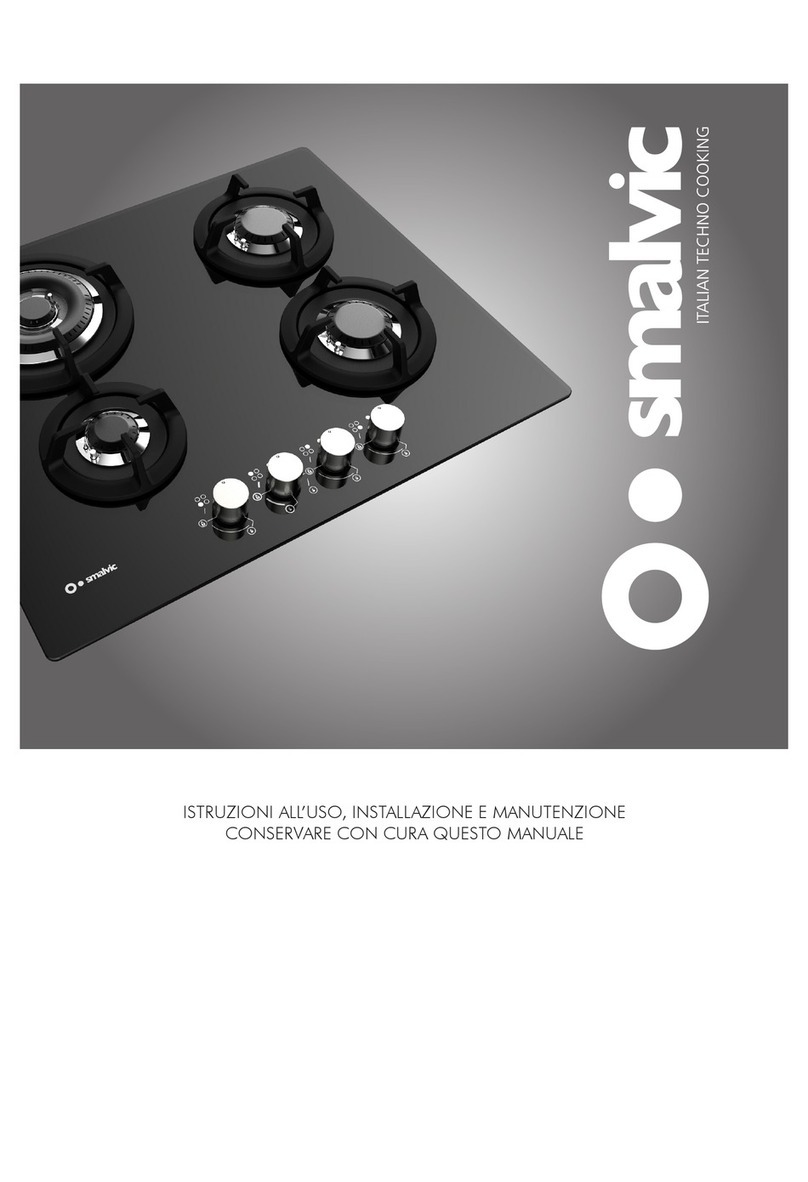
Smalvic
Smalvic PI-MX60V3GITC Operation instructions
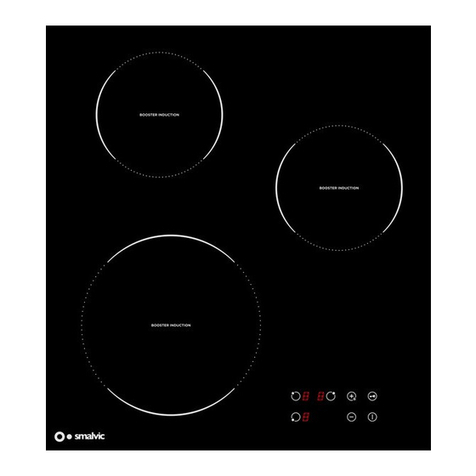
Smalvic
Smalvic 1023850400 User manual

Smalvic
Smalvic SPVC75 Technical specifications
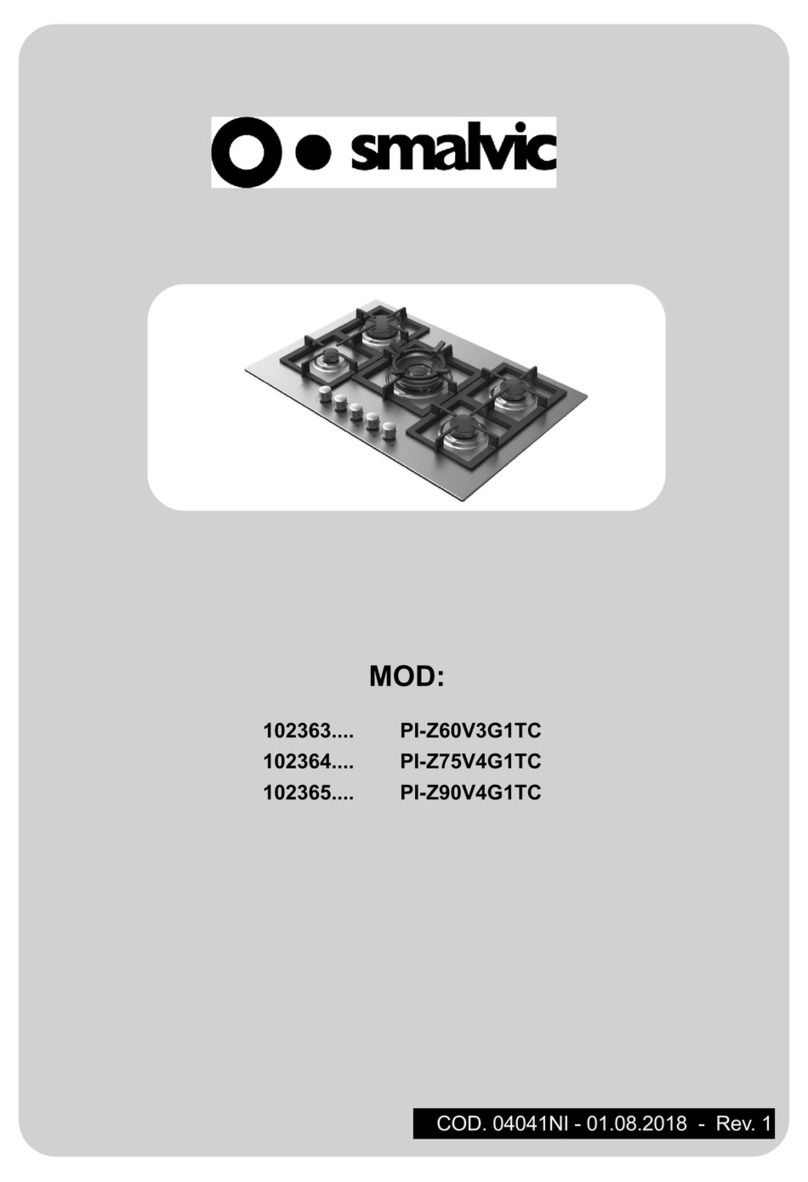
Smalvic
Smalvic PI-Z60V3G1TC User manual
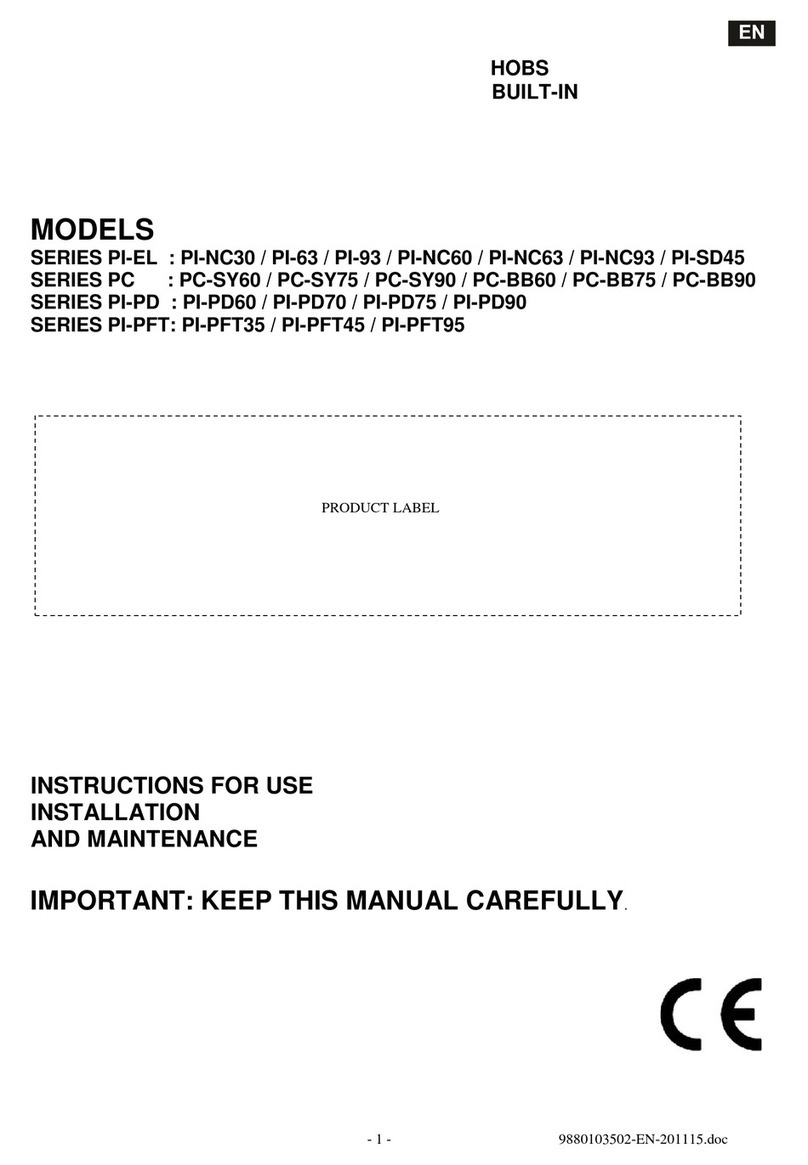
Smalvic
Smalvic PI-EL SERIES Troubleshooting guide

Smalvic
Smalvic PG38-2IND Quick start guide

Smalvic
Smalvic 1023840400 User manual
